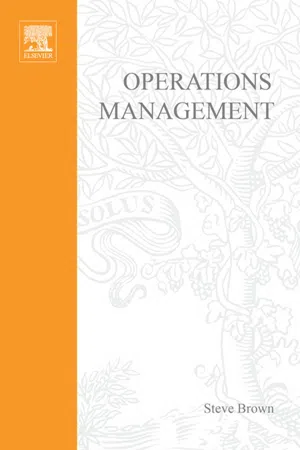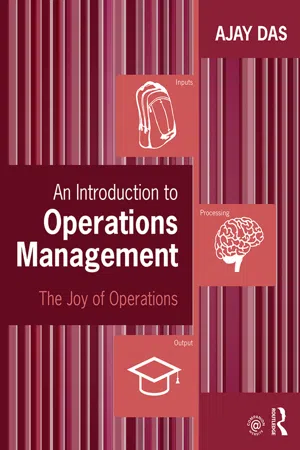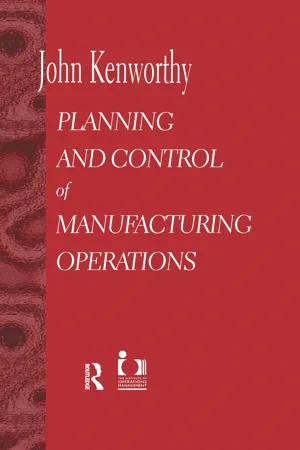Capacity
Capacity in business refers to the maximum level of output a company can produce, or the resources it can effectively utilize. It encompasses both physical and human resources, and is crucial for determining a company's ability to meet demand and grow. Understanding and optimizing capacity is essential for efficient operations and strategic planning.
8 Key excerpts on "Capacity"
- Steve Brown, Kate Blackmon, Paul Cousins, Harvey Maylor(Authors)
- 2013(Publication Date)
- Routledge(Publisher)
...Like other policy decisions, this involves making trade-offs between investing in productive resources and making the best use of them. On the one hand, transforming resources such as facilities, technology, and people are generally expensive and take time to acquire or create, so the organization wants to use them wisely. On the other, materials, information and effort may be wasted if they are acquired or transformed when there is no demand for them, while sales may be lost if outputs are not available when needed by consumers. Defining Capacity In operations management, the term Capacity describes the level of output that the organization can achieve over a specified period of time. Capacity can be defined in several different ways, and some of these are described below. Theoretical Capacity One definition of Capacity is the maximum level of output that can be attained by the organization, theoretical Capacity, which is the level of output that can be achieved if the organization's resources are used fully. This would mean operating 24 hours per day, 7 days per week, 365 days per year, and for all but continuous production this is clearly unrealistic. Many manufacturing operations and most service operations operate either during fixed hours, such as 9 am to 5 pm, Monday to Friday, or have some periods where operations are minimal. A university might be able to double or triple the level of students through scheduling lectures around the clock, including weekends and holidays, which would make very efficient use of its lecture theatres; however, it wouldn't be very popular with students or faculty! Design Capacity Even facilities running continuously find it difficult to achieve 100 per cent productive time; they must generally shut down at least periodically for maintenance and cleaning. A second definition of Capacity is design Capacity. This is the level of output that the operation was designed to have, which includes allowances for planned non-productive time...
- Su Mi Dahlgaard-Park(Author)
- 2015(Publication Date)
- SAGE Publications, Inc(Publisher)
...Capacity Management Capacity Management 55 59 Capacity Management In a global context, Capacity can be defined as a specific ability toreceive, store, produce, and/or service. Capacity also refers to thequantitative and qualitative potential of a production or service systemwithin a planned period of time and a determined business strategy (e.g.,make-to-stock, make-to-order, assemble-to-order). To be more specific, theCapacity of an asset represents its capability to participate in aproduction and/or service process in a technologically and economicallyrational way. Because of the inability to store services or simultaneousproduction and consumption, in a service economy, Capacity must be preciselymatched with the timing of demand. Thus, service Capacity management is seenas more complex than that of manufacturing. The Capacity has strongimplications for competitive performances, and for this reason, it must bemanaged. Capacity management is the syntagma used in manufacturing andservice companies to map out their capabilities. It includes the proactiverole, more commonly known as Capacity planning by utilizing aforward-looking approach, and the reactive role, driven by operative shopfloor or department problems. This entry is organized around three concerns. In the first section, aconceptual framework of Capacity management is given throughout long-,medium-, and short-range planning horizons. The next part of the entryfocuses on the basic manifestation of shapes and calculations of capacities.Finally, the third section considers the discrepancies of the capacities andguidelines for capacities smoothing. Capacity Management Framework Capacity management is a traditional concept for industrial production.In the fields of service and logistics providers, the theory of Capacitymanagement does not yet apply to the entire domain...
- eBook - ePub
An Introduction to Operations Management
The Joy of Operations
- Ajay Das(Author)
- 2015(Publication Date)
- Routledge(Publisher)
...Capacity planning does not always target 100 percent fulfillment of user demand or 100 percent utilization of available Capacity. The goal of Capacity planning is to minimize the discrepancy between demand and Capacity in a cost-effective, revenue-effective, quality-effective, and safety-effective manner. Capacity is the upper limit of a system’s ability to make, store, deliver, or receive products or services at a point in time. Design or peak Capacity is the maximum output Capacity possible, usually sustainable for a short period of time. Effective Capacity or the best operating Capacity level is the Capacity of the resource under normal operating conditions Fixed Capacity represents investments in assets that cannot be reversed easily such as land, equipment, and permanent hires (or classroom Capacity by law). Variable Capacity represents investments that can be recovered or changed relatively easily, such as outsourcing contracts, personnel overtime, and temp hiring. With standard products, Capacity can be measured in terms of finished product or service output, e.g. number of cars/year; number of pizzas/day, number of rooms. With multiple products, Capacity can be measured in terms of input resource availability, e.g. number of ER doctors available per shift, number of beds. Capacity utilization is the amount of design Capacity that is utilized on average in fulfilling demand. Capacity utilization cannot exceed design Capacity: Capacity Utilization % = Actual average output or extent of resource use Design Capacity * 100 Efficiency is the amount of effective Capacity that is utilized on average in fulfilling demand: Efficiency % = Actual average output or extent of resource use Effective Capacity * 100 A high efficiency ratio is not necessarily good news if the effective Capacity is low relative to design Capacity on account of poor maintenance, poor quality, or worker mismanagement...
- Peter Cheng, Yelin Fu, Kin Keung Lai(Authors)
- 2018(Publication Date)
- Routledge(Publisher)
...7 Production Capacity planning via robust optimization 7.1 Introduction Production Capacity planning is the process of determining how much production Capacity to acquire and how to plan its utilization to meet fluctuant market demands (Escudero et al., 1993), which is typically arisen in manufacturing industry. This uncertainty generally leads to uneven or unpredictable Capacity utilization. In the context of Capacity planning – Capacity is considered as the maximum amount of techniques, raw materials, skilled manpower, machines and other production facilities – all of these factors can be integrated to be the amount of plants. The traditional way of dealing with uncertain demand is to collect opinions from a group of experienced managers and then select the most likely forecast of demand for different products. The Capacity is planned such that all plants have a sufficiently high utilization while fulfilling the projected demand. However, such Capacity planning has often resulted in either lower utilization of Capacity if the actual demand materialized is less than the projected, or additional cost associated with Capacity expansion if the actual demand is higher (Swaminathan, 2000). Managers in the manufacturing industry are significantly interested in developing an effective Capacity planning policy that enables hedging against the uncertainty. Capacity planning typically consists of two parts: (1) plant building decisions have to be made before the actual market demand is realized and (2) once the demand is materialized, different types of orders representing different demands need to be allocated to different plants, with the objective to minimize the weighted sum of the total investment required for building the plants and the additional cost associated with Capacity expansion...
- eBook - ePub
Service Science
Analysis and Improvement of Business Processes
- John Maleyeff(Author)
- 2020(Publication Date)
- Routledge(Publisher)
...For example, a flu epidemic that affects many auditors simultaneously during the key auditing periods could cause great disruption. Strategies to mitigate this risk may include ensuring that all employees receive flu shots, or contracting with companies so that auditors can be hired quickly on a temporary basis. Risk management of a business process is covered in Chapter 14. Key Definitions Capacity planning should ensure that future resource availability exists when needed. If done effectively, an appropriate balance is maintained between the needs of the customer (to be serviced promptly) and the needs of the firm (to provide service at reasonable costs). The Capacity planning process should be done in a structured manner to ensure that this balance is maintained. Planning is itself a business process that requires the planner to manipulate resources (mainly workforce) to best meet the needs of customers by being available when and where the demand for the resource exists. A few formal definitions are required: Resource efficiency is the percentage of time that a resource would be expected to operate after any unplanned disruptions, such as power (or network) outages, washroom breaks, equipment downtime (e.g., replacing a laser printer’s ink cartridge), etc. The disruptions would typically not include meals or other scheduled breaks. Capacity is the amount of work a resource can do, usually expressed in jobs per time interval, such as customers per hour. Capacity may or may not be adjusted based on resource efficiency. In the remainder of this chapter, Capacity will include an adjustment for resource efficiency. Capacity buffer is the percentage of time the planner reserves due to uncertainty in customer demand and/or activity time variation...
- eBook - ePub
- Frank Rowbotham, Masoud Azhashemi, Les Galloway(Authors)
- 2012(Publication Date)
- Routledge(Publisher)
...CHAPTER 6 Planning and control of work: the management of Capacity This chapter deals with the management of Capacity, which is the ability of an organization to process the amount of work demanded of it. In considering this area of operations management several topics are covered. Learning objectives 1 Planning and control. The basic task of Capacity management is to provide the right number of staff, with the right facilities and technology in the right place at the right time. This task cannot be achieved without there first being a plan showing how these resources are to be allocated. Once framed, the implementation of the plan needs to be monitored. Feedback is required from the operation to show if the plan is being achieved. The planning process is thus a dynamic one and plans seldom stay unchanged as the operation attempts to adjust to the demands placed upon it. 2 Forecasting. One of the basic difficulties in planning for the future allocation of Capacity is to know what the future demand for work is likely to be. In part, the prediction of future demands will rest upon what the managers of the organization know about the behaviours of their customers and users. This knowledge is qualitative and is obviously a potentially very useful source of ideas about what the pattern of demand is likely to be. However, it is unwise to rely solely upon such ‘instincts’ and quantitative data showing the history of actual demand patterns is vital to help the managers of the operation make as accurate an estimate as possible. Some of the simpler quantitative forecasting techniques are illustrated in the supplement to this chapter. 3 Differing planning time horizons. Some of the lead times involved in allocating Capacity can be very long. The building of a brand new operation, for instance, will require a long process of research, planning and execution. It is quite likely that this process will be measured in terms of years...
- eBook - ePub
- Andrew Greasley(Author)
- 2019(Publication Date)
- Routledge(Publisher)
...This process means that the organization can build on previous plans instead of attempting to devise new plans at each planning cycle. This reduces planning time and leads to more continuity in decision-making. Measuring Capacity Measuring Capacity may seem straightforward at first, especially when compared to the uncertainty inherent in estimating demand. However, Capacity is not fixed but is a variable that depends on a number of factors: Capacity takes many different forms, such as storage space, availability of employee skills, equipment numbers and transportation facilities. Any of these types of Capacity may be the limiting factor or bottleneck on the Capacity of a process. The actual bottleneck, and thus Capacity, may also change over time. Working practices such as hours worked and holiday entitlement can also affect Capacity calculations and may change over time. For example, a change in company policy may decrease the hours a week that employees can work and thus reduce Capacity. The amount of Capacity required to deliver a particular process at a particular level may change over time, due to the experience gained and improvements made to process design. The Capacity available in multiple locations may not be simply summed as transportation time, and costs may make available Capacity in a particular location unsuitable. Capacity is based on time, so underused Capacity due to a drop in demand cannot be used later, when demand increases. Thus, the actual Capacity available will be less the more that demand fluctuates. Process time fluctuations will also affect Capacity. Measuring Capacity in services is a particular challenge. Generally, services need to be more custom-designed and involve more personal contact to meet specific customer needs. Customer involvement tends to provide an opportunity for special requests and instructions to be issued by the customer, and they tend to disrupt routine procedures and thus efficiency...
- eBook - ePub
- John Kenworthy(Author)
- 2013(Publication Date)
- Routledge(Publisher)
...9 Capacity planning and short term scheduling Chapters 2 and 3 demonstrated how MRP is based on material needs, and how the automated parts of the calculation assume that production Capacity is always available when required. It was also shown that plans must be realistic with respect to Capacity if order due-dates are to be met reliably. This chapter will look at techniques available for planning Capacity and show how they relate to production planning and scheduling. Finally, the relevance of lead times to Capacity planning will be discussed. In order to carry out a calculation of the load imposed on a particular resource by a manufacturing order, several key pieces of information are required. These are: Which resource ? i.e. with which piece of equipment, group of machines, person or group of people is the calculation concerned? How much resource is needed ? This has a variable element, the time required to process one unit of product (e.g. one part or one pack) and a fixed element, the set-up or change-over time. When is the resource required ? How this is determined depends on the approach being adopted but it is normally related to the due-date of the manufacturing order utilising the resource. The two most used forms of Capacity planning are Capacity Requirements Planning (CRP) which looks at Capacity in detail but because of computing time limitations has traditionally only been used typically to look up to six months ahead, and Rough Cut Capacity Planning (RCCP) which, as its name implies, is rather rough and ready but simple and quick to use...







